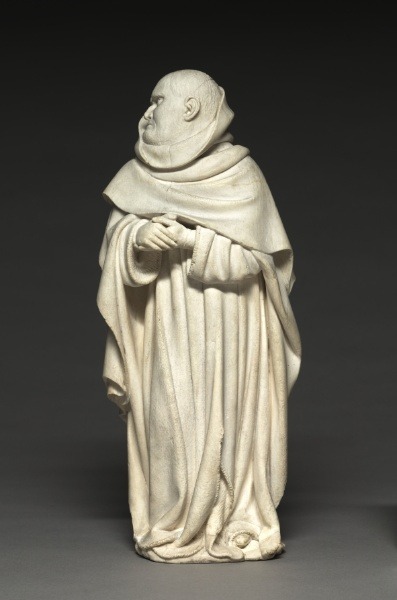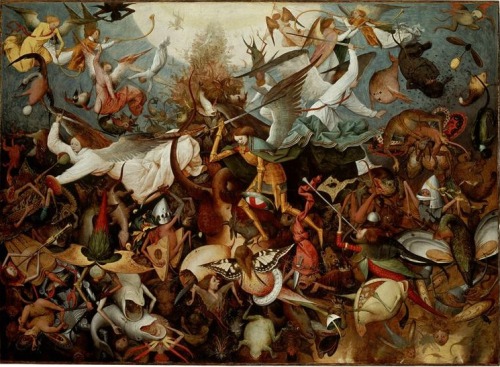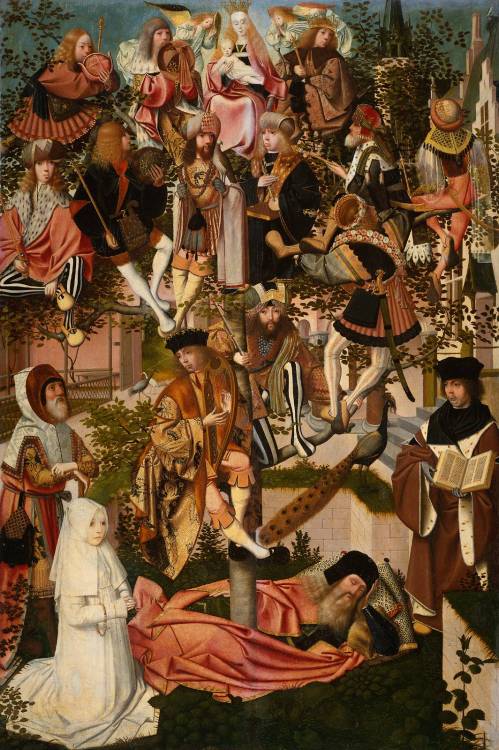#netherlandish art
Rogier van der Weyden - Hubertus panels;
Left: Exhumation of St. Hubert
Right: Dream of Pope Sergius
1435/1440
Post link
Claus de Werve (Netherlandish, 1380-1439)
Mourner from the Tomb of Philip the Bold, Duke of Burgundy
1404-1410
Alabaster
“Throughout most of their history these alabaster mourners have evoked a sense of awe and mystery as well as curiosity and admiration. They were originally arranged in processional order around the sides of the ducal tomb within a marble arcade in the Chartreuse de Champmol. The realistically carved mourners remain the most famous elements from Philip the Bold’s tomb. Carved by Claus de Werve, no two are alike. They retain minute details of costume and features, and the faces of some are nearly portrait-like in their depiction of facial creases and expression, suggesting actual individuals, while the faces of others are partly obscured by their cowls.”
One of three mourners currently in the collection of the Cleveland Museum of Art. Image and description from the Cleveland Museum of Art’s online collection pages (1,2, and 3 (shown here)).
Post link
Claus de Werve (Netherlandish, 1380-1439)
Mourner from the Tomb of Philip the Bold, Duke of Burgundy
1404-1410
Alabaster
“Throughout most of their history these alabaster mourners have evoked a sense of awe and mystery as well as curiosity and admiration. They were originally arranged in processional order around the sides of the ducal tomb within a marble arcade in the Chartreuse de Champmol. The realistically carved mourners remain the most famous elements from Philip the Bold’s tomb. Carved by Claus de Werve, no two are alike. They retain minute details of costume and features, and the faces of some are nearly portrait-like in their depiction of facial creases and expression, suggesting actual individuals, while the faces of others are partly obscured by their cowls.”
One of three mourners currently in the collection of the Cleveland Museum of Art. Image and description from the Cleveland Museum of Art’s online collection pages (1,2 (shown here), and 3).
Post link
Claus de Werve (Netherlandish, 1380-1439)
Mourner from the Tomb of Philip the Bold, Duke of Burgundy
1404-1410
Alabaster
“Throughout most of their history these alabaster mourners have evoked a sense of awe and mystery as well as curiosity and admiration. They were originally arranged in processional order around the sides of the ducal tomb within a marble arcade in the Chartreuse de Champmol. The realistically carved mourners remain the most famous elements from Philip the Bold’s tomb. Carved by Claus de Werve, no two are alike. They retain minute details of costume and features, and the faces of some are nearly portrait-like in their depiction of facial creases and expression, suggesting actual individuals, while the faces of others are partly obscured by their cowls.”
One of three mourners currently in the collection of the Cleveland Museum of Art. Image and description from the Cleveland Museum of Art’s online collection pages (1 (shown here),2, and 3).
Post link
Pieter Bruegel the Elder
The Fall of the Rebel Angels
1562 oil on panel
Royal Museums of Fine Arts of Belgium, BrusselsImage taken from ARTstor
Post link
Hans Memling
Last Judgement
1467-71
Oil on panel
Commissioned by Angelo Tani, an Italian banker with the Medici bank in Bruges. The kneeling figure being weighed by St. Michael is believed to be Tommaso Portinari, who took over Tani’s position at the bank in Bruges. Portinari, along with members of his family, can be seen in donor portraits in Hugo van der Goes’s Portinari Altarpiece, c. 1475.
This painting is in the collection of Poland’s National Museum in Gdańsk. Image taken from Wikipedia.
Post link
Circle of Geertgen tot Sint Jans
The Tree ofJesse
1500
Oil on panel
“Pictured here symbolically is Christ’s family tree. It grows out of the sleeping figure of Jesse, forefather of a line of kings that included, according to tradition, Solomon, David, and Jesus. The branches are filled with the kings of Israel, among them King David with his harp. At top, the Virgin is enthroned with the Christ Child on her lap.”
Description and image taken from the Rijksmuseum’s website.
Post link









